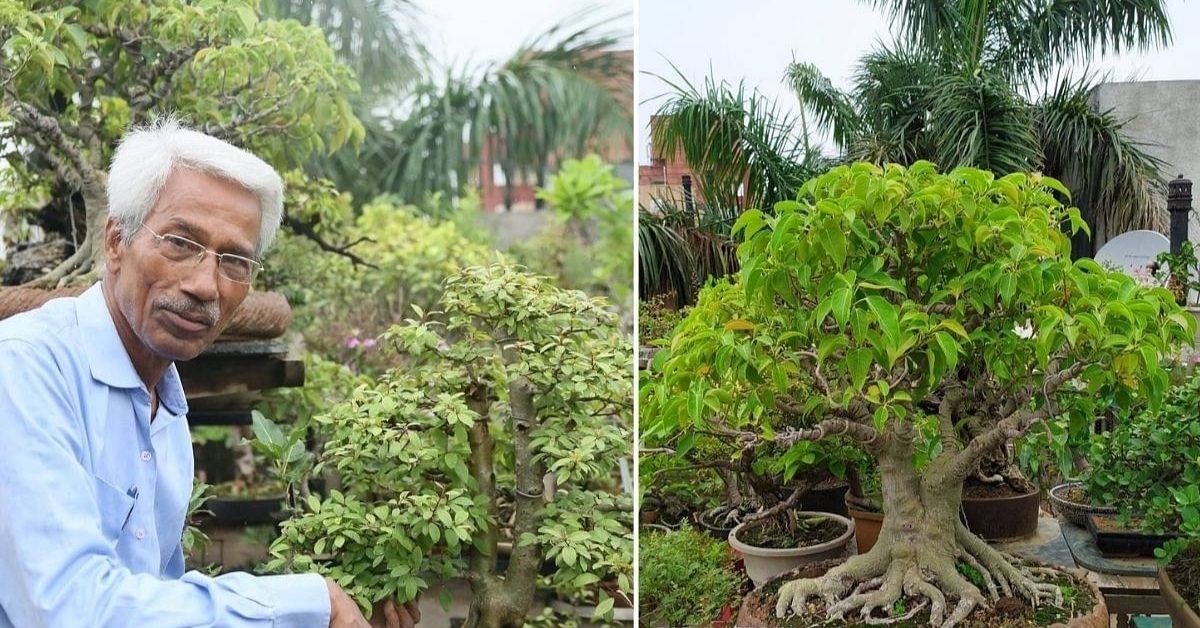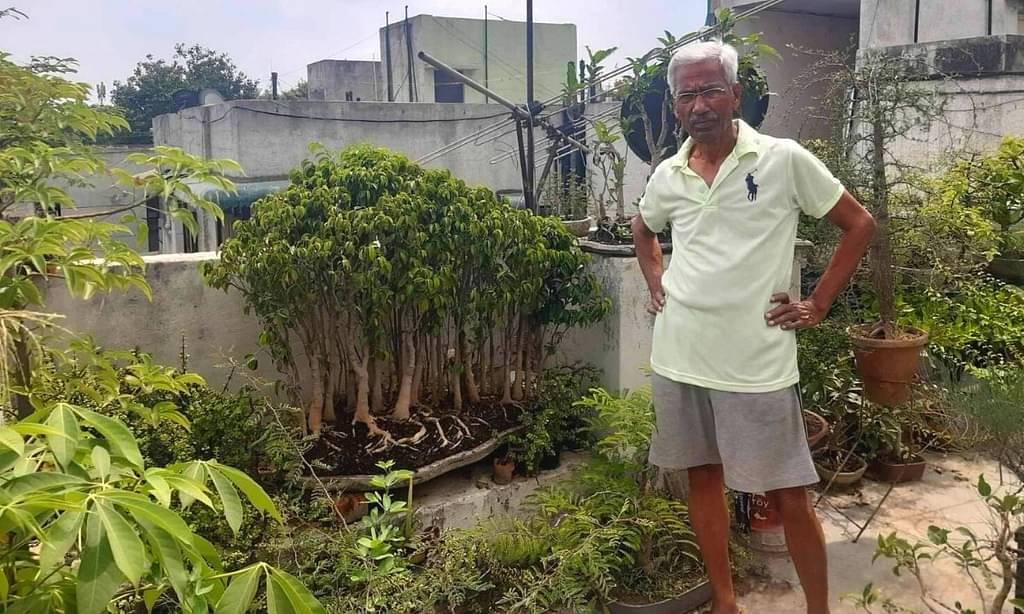How to Grow a Bonsai Garden: This Banker Has 550 Trees on His Terrace!
Delhi resident Mangat Singh Thakur has dedicated his retirement to nurturing a bonsai garden on his terrace, and shares tips and tricks on how you can grow these miniature plants yourself.

Mangat Singh Thakur, an 80-year-old retired banker from Rohini, Delhi, was in his forties when bonsai were first introduced to India in the late 70s.
This, he notes, was thanks to the efforts of Nikunj and Jyoti Parekh, who founded the Bonsai Study Group of The Indo-Japanese Association. A few years later, he says, Dr Leila Dhanda popularised the art form in the capital when she set up the Indian Bonsai Association. “And I had the fortune of running into a group of women who worked for her, at a kitchen garden I used to frequent,” he says.
“I didn’t even know what a bonsai was back then, and funnily enough, they didn’t have much of an idea either. However, they explained the basics and I attended my first workshop at (ITC) Maurya Sheraton soon after. I come from very humble beginnings and felt hesitant about even entering the hotel premises. But as I found out more about how to grow bonsai plants at home, I only became more interested in the art,” he adds.
Despite his inclinations, Mangat’s work and family responsibilities kept him preoccupied until 2001. Then, as a retired man, he could finally dedicate the better part of his days to perfecting a green thumb, and presently nurtures as many as 550 bonsai plants on his rooftop terrace in Rohini.
“It was about 35 years ago that I potted my first bonsai, a banyan tree. I still have it today. During the initial years, I used to spend hours pondering over books on bonsai techniques. But from the dozens of books available in my neighbourhood’s libraries, only a few were penned in Hindi. I decided if I’d ever get the chance, I’d write one myself. And now, I am,” Mangat tells The Better India.
SInce 2019, he has also been sharing detailed tutorial videos about the exotic plant’s cultivation and maintenance on Bonsai Factory, his YouTube Channel with nearly 9,000 subscribers.
“For the past few years, my main goal has been to ensure that bonsai techniques reach the common man across the country. If we introduce it to marginalised farmers from rural and remote regions, they can properly utilise their existing land and resources to establish an extremely profitable model. With my videos, [I hope] they can at least discover that they have the option to do so, and figure out how to get started,” he adds.
While Mangat is done authoring his book, he says the accompanying photographs and illustrations are yet to be completed, adding that he is eyeing a release in April next year.

‘More of an artwork than hard work’
“The best thing about growing bonsai is that you do not need any special seeds to get started. You can use any plant that has the capacity to grow into a tree,” he notes. “Here, ‘bon’ means ‘tray’ and ‘sai’ means ‘tree’. So it’s not a separate species, rather a miniature form of a larger tree. Still, I find it really fascinating that the fruit from a bonsai plant is the same size as that from a tree.”
“People often make bonsai cultivation to be a time-consuming and expensive affair. But it’s more of an artwork than hard work. If you spend time understanding the fundamentals of nourishing a bonsai plant, you will be able to make one easily and ensure it survives for decades,” he says.
Since the inception of the COVID-19 pandemic in 2020, Mangat also started taking online classes to spread awareness on bonsai cultivation techniques. He says the sessions are priced at Rs 5,000 per participant for a batch of 15 days, and that they focus on only the theoretical concepts for the first 10.
“Even a doctor spends two-thirds of his life buried in books. I don’t claim that I can make anybody a master of the subject within two weeks, but one does learn enough to pursue it with consideration. I’ve taught more than 150 people so far, from high school students to principals, pilots and engineers. I am proud to be doing this work at 80,” he shares.
How to make a potting mix for bonsai plants:
Mangat points out that the first thing to keep in mind while growing bonsai plants is that their maximum size is only three feet. “They’re grown in a confined space, and in limited soil, so their roots do not spread like large trees and require more nutrition through the soil,” he says.
“There are plenty of things to take care of while preparing the potting mix. It should be lightweight, but jam-packed with nutrition at the same time,” explains Mangat. “For this, you can combine 15% of nursery soil, 10% manure, 3% neem cake fertiliser, 4-5% chalk, 10% of pit sand (badarpur), 5% brick pieces, 5% raw coal pieces, 2% ash fertiliser, 10% of coir dust, 10% of bonemeal, and 15% dry leaves. You could also add some pieces of rotten wood to enhance the mix.”
After mixing these ingredients well, Mangat says, one must pass the mix through three types of sieves with varying sizes of holes. “After filtering the potting mix through the first sieve, the coarse stones or twigs that are left behind must be kept separately in a plastic container. This is the first type of soil,” he adds.
After filtering the potting mix which is left, pass it through the second sieve. Remove the soil which is left in this sieve and keep it in another vessel — this is the second type of soil.
Now, the soil that you get after sifting through the second sieve has to be filtered through the third sieve. The soil that does not filter through the third sieve is the third type of soil. After this is filtered, the leftover fine soil is the fourth type of soil.
The soils should not be stored in any polythene, rather collected in separate utensils or containers, and dried out in the sun. “We need thick clay for bonsai. If we keep its soil in polythene, then moisture gets in and the soil starts breaking. One should also avoid mixing any kind of chemicals in the bonsai soil, as that shortens its lifespan,” explains Mangat.
Before planting bonsai in a pot, one first has to put the ‘thick soil’ — the first type of soil. After this, the second type of soil has to be added, then the third, and layers have to be pressed hard with hands. Do not fill the pot completely.
Now, place the bonsai plant in it. Add more soil and press on it with the help of any wood. Now, place the bonsai in a tub or bucket filled with water. After keeping it in water for three to four hours, place the bonsai in a location with shade.
Other tips for bonsai care:
- Mangat says watering bonsai is also a work of art. You can’t add as much water to it as other trees. Keep in mind that you give water in such a way that it does not stay in the pot at all. Bonsai roots are small and if there is any water stagnation in the pot, the roots start getting damaged, he notes.
- Avoid giving any kind of chemical fertilisers; it is recommended to use only organic manure in bonsai.
- Do not apply too much fertiliser in one go. You can apply small amounts of manure at intervals of one week in a month, three to four times. This makes the bonsai more healthy.
- Wires are used to make bonsai. Therefore, you also have to keep checking to see if any wire is harming the bonsai periodically. If you feel that the wire is cutting the bonsai, you can remove the wire and restructure it again.
- One must regularly prune and ‘repot’ the bonsai plants, Mangat says.
- After undertaking to repot, one does not have to fertilise the bonsai for about a month, he adds. Then, you may give the plant liquid manure, only in the evening. Along with the roots, the bonsai leaves must be sprayed as well.
For further information, you can follow Bonsai Factory.
You can read this story in Hindi here.
This story made me
- 97
- 121
- 89
- 167
Tell Us More
We bring stories straight from the heart of India, to inspire millions and create a wave of impact. Our positive movement is growing bigger everyday, and we would love for you to join it.
Please contribute whatever you can, every little penny helps our team in bringing you more stories that support dreams and spread hope.



















